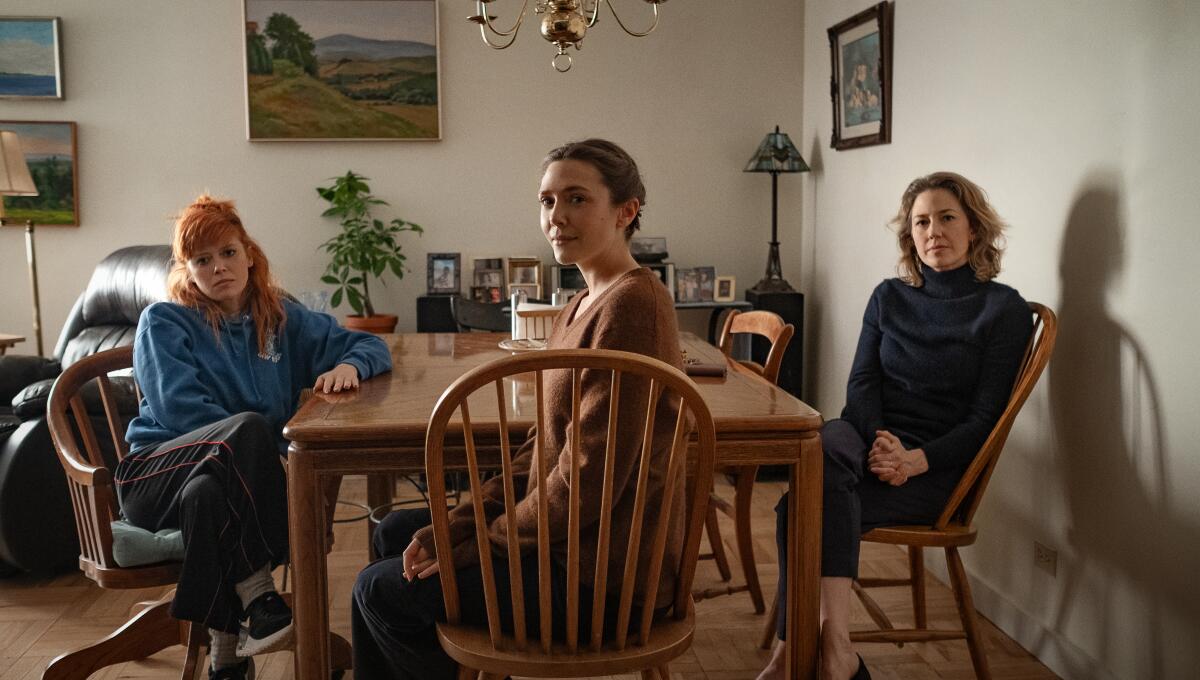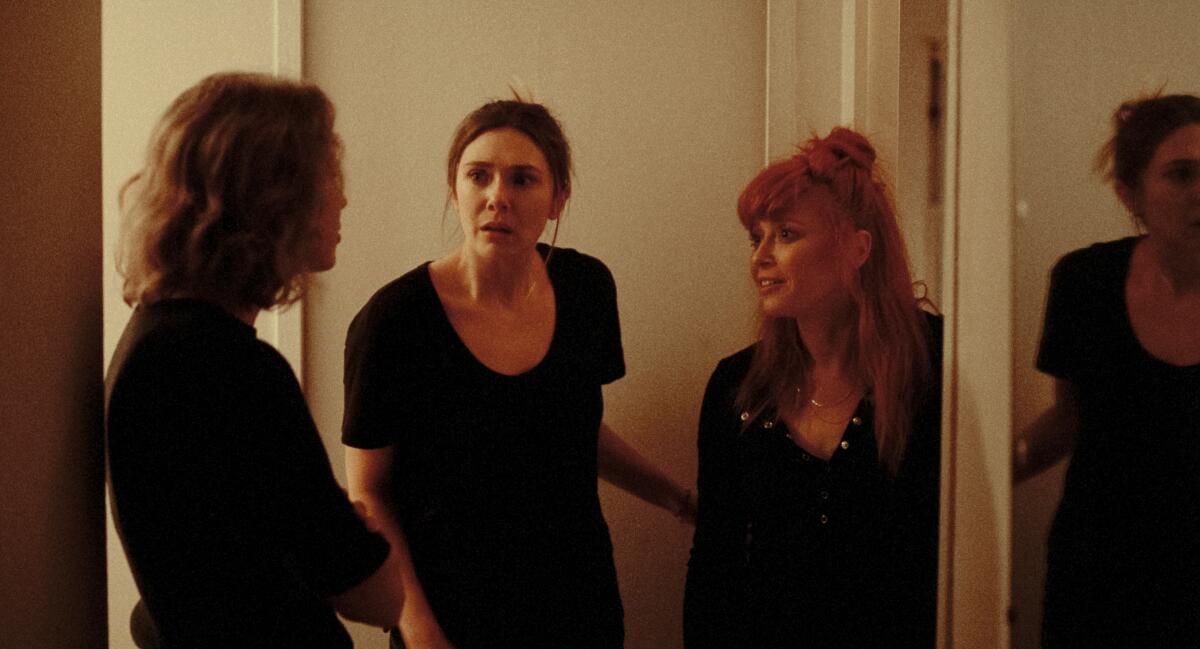
Nothing brings people together quite like the death of a loved one. But also, nothing brings out the small slights, simmering resentments and long-term emotional connections quite like the death of a loved one.
The new film “His Three Daughters” explores all of that in acute, observant detail. Written and directed by Azazel Jacobs, the film follows three sisters, not exactly estranged but definitely not close, who find themselves back together in a small New York City apartment as their father lies in hospice care.
The film is a powerful spotlight for performances by Carrie Coon, Elizabeth Olsen and Natasha Lyonne, all of whom manage to bring unexpected turns to their seemingly well-established screen personas. Coon’s intimidating Katie, Olsen’s reticent Christina and Lyonne’s disaffected Rachel all show new sides — to each other but also to themselves — by the time the story is done.
“It goes back to that whole ‘Breakfast Club’ thing, which is: How do you expect us to sum ourselves up?” Jacobs says in a video interview from his apartment in New York. “ ‘I’m the domineering person, I’m the flighty person, I’m the laid-back stoner.’ And hopefully by the end they’ve untethered and revealed something quite more flawed and human than that.”
Having premiered at last year’s Toronto International Film Festival, the movie was acquired by Netflix for a reported $7 million. Following a limited theatrical release, including some screenings in 35mm, the film begins streaming on the platform on Friday.

Jacobs wrote his script with these three actors in mind, knowing he had a connection to each and could get the script to them directly. Jacobs had directed Olsen in episodes of the series “Sorry for Your Loss.” He met Coon after directing her husband, the actor and playwright Tracy Letts, in his previous films “The Lovers” and “French Exit.” He met Lyonne after going with actor Lucas Hedges to Lyonne’s 40th birthday party, a screening of the film “The King of Comedy.” The two then became friendly on Instagram.
Though Coon had met Jacobs socially, she was still surprised to receive a script written with her in mind.
“I didn’t know how he thought of me as an actor, if he even considered me in that way,” says Coon, a recent Emmy nominee for her role on “The Gilded Age.” “So I was very flattered when he revealed that he had written this part. And of course, Tracy said, ‘Well, you’re doing it.’ And that was before I even read it, because he so loves working with Aza. He knew I would have a wonderful time.”
When she did read the script, Coon liked what she found.
“I often play very verbal, highly intense women,” says Coon. “And so in some ways it was, by all observation, in my wheelhouse, as they say. And I am an older sibling and I am overbearing and controlling, and think they should all take my advice. And so it’s not far from me in that way.”
For Olsen, the part of the shy, recessive Christina felt more distanced from her recent roles in the series “Love & Death” or as part of the extended Marvel Cinematic Universe.
“I don’t find myself to be that sweet and sensitive, but I am, in ways, and Aza knows a lot about me personally and my own day-to-day life that I go through and things I don’t share with many people,” says Olsen. “And so to find something smaller within me and quieter, very vulnerable, it felt like a nice opportunity even though it wouldn’t necessarily have felt like the thing I was dying to do next. I had this opportunity to go to a softer place than I’m usually drawn to.”
At a time when she is very busy as a producer, director, writer and showrunner on projects such as “Russian Doll” and “Poker Face,” there is still something satisfying for Lyonne in acting in someone else’s project — just to be, in her words, “like a Traveling Wilbury or something. I’m just out here being a session musician and the gig is to service the idea as best you can. I love to be a part of watching somebody make their thing.”

Jacobs broke through with his third feature, 2008’s “Momma’s Man,” which featured his actual parents, artist Flo Jacobs and avant-garde filmmaker Ken Jacobs, in their Tribeca loft and there is something full-circle in seeing him return to a story so tied to family, aging and New York housing.
To find the specific apartment Jacobs had in mind, he and his co-producer, the costume designer Diaz Jacobs (also the director’s wife), handed out fliers on the street. He called people he hadn’t spoken to in years. He discovered the apartment they ultimately used through someone he knew since he was a teenager. A unit on the Lower East Side, it had only recently been purchased, which meant it wasn’t fully furnished. Most crucially, a dividing wall typically knocked down by contemporary owners was still standing.
“It was important for me to not write about an artist’s loft,” says Jacobs. “I wanted this family to exist outside of my own. I grew up going to lots of these apartments. I knew it from sleepovers or visiting friends. And it was super important to me to use the actual structure as a limitation.”
Jacobs and cinematographer Sam Levy, whose credits include “Frances Ha,” make the most of the limited space. In the early stages of the film, the three sisters are seen only in individual shots locked off from one another. Gradually, two of them may appear together in a shot, but it is not until well into the film that the three performers are all together on-screen.
“The experience of the film, it mirrors the relationship of the sisters,” Coon says. “Form follows function in such a beautiful way and in a way that is so rarely done. You just rarely see this level of craftsmanship in an industry that’s moving at breakneck speed to make money.”
The production used other apartments in the building as holding areas in between takes, with Coon and Olsen in one and Lyonne in another to heighten the feelings of isolation felt by her character. But the three of them ended up spending time together anyway.
“It was lovely to kind of be on top of each other all the time and to giggle and to get into each other’s personal lives and then be called to set and Aza having a hard time wrangling us because we’re so obsessed with whatever it is that we’re doing together,” says Olsen. “I feel like all the photos that Aza has taken of us when we were off camera, I feel like our limbs are all tangled within one another. It created a different energy, kind of like there’s nowhere to escape. You just have to deal with what’s real and what’s there.”
“We would just spend all our time running up and down the stairs in the building,” recalled Lyonne.

All three actors have been pleasantly surprised by the response to the film from audiences. A small, independent movie that arrived at a festival a year ago without distribution has steadily been impressing audiences at screenings and is now beginning to generate talk of awards consideration.
“I’m really grateful that people are connecting to it,” says Lyonne. “It’s absolutely true that I don’t think any of us expected this. It’s really something for us all to remember, that it’s always the unexpected ones. How beautiful it is that we are impacted by these kind of surprises. It’s a reminder to keep an open mind when we’re green-lighting or reading or thinking that we’re making these strong choices and building out these imaginary careers and ‘Gotta win at life.’ Well, spoiler alert, we die at the end.”
Whereas “Momma’s Man” was inspired by Jacobs seeing people his age begin to have babies and “The Lovers” came from a wave of divorces around him, “His Three Daughters” grew out of seeing people his age lose their parents, as well as his parents having their own health issues.
The film captures the specific end-of-life agony of simply waiting: the agonizing period where there is little to be done and the smallest detail — a signature on a piece of paperwork, what to have for dinner — can take on huge meaning simply because it is a task that can be accomplished.
“That experience of waiting is what actually sat me down to write,” says Jacobs. “Time moves in the strangest way. Like every second suddenly counts. Emails don’t matter. Everything doesn’t matter except this. Then you realize there’s a shift, suddenly emails do matter again and life outside does matter. This thing that you did not want to happen, suddenly you are resigned that it is happening.
“And there really felt like three acts in that,” Jacobs says. “That’s why it was so important for me to edit this film. I know that there’s been this comparison to plays, but the truth is that we’re not seeing time move in the way that a play would at all. I could take advantage of time so that some things can move fast. Some things can move slowly, time could collapse. It doesn’t move like real time. And that’s what death feels like to me.”